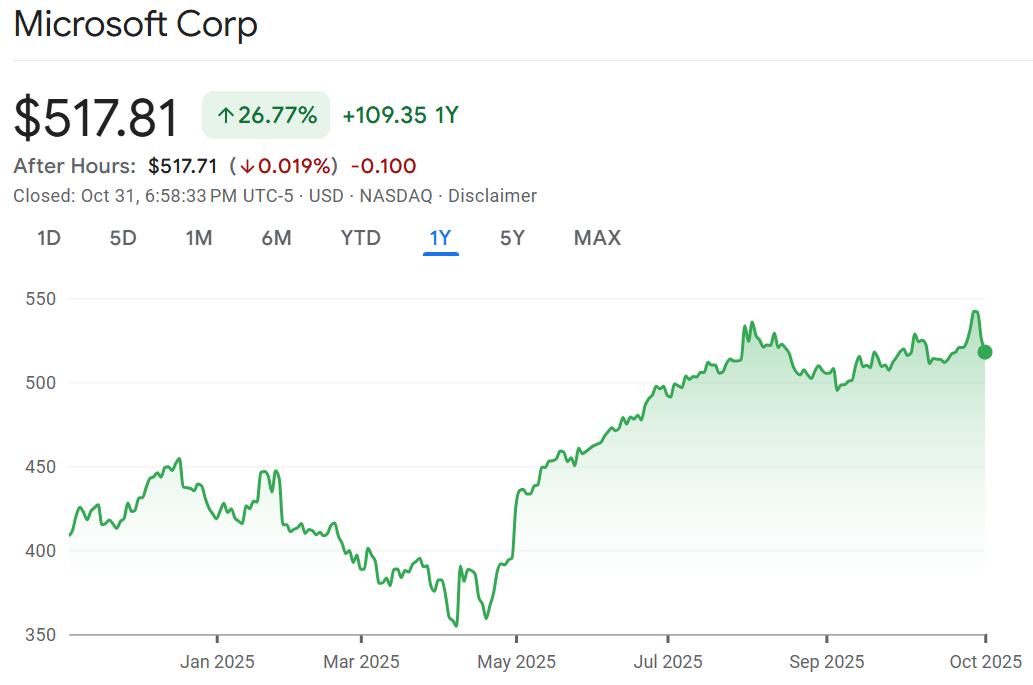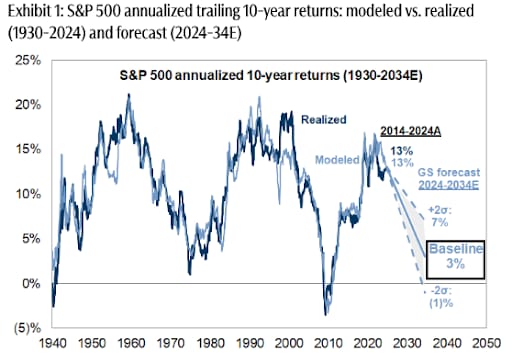- The Pragmatic Investor
- Posts
- 💰 Why Microsoft’s $35B Bet Might Be Genius
💰 Why Microsoft’s $35B Bet Might Be Genius

🌞Good Monday Morning, Folks!
It’s not the miss that hurts investors. It’s when a company wins big… and still gets punished.
That’s exactly what happened to Microsoft (MSFT).
The company posted another blockbuster quarter: revenue up 18% to $77.7 billion, operating margin at 49%, and Azure and AI services up a staggering 40%.
Those are elite numbers — the kind that should have pushed the stock higher.
But instead, the market sold it off. Shares dropped about 2–4% after the earnings release, even though the results crushed estimates.
Why? One number.
$34.9 billion.
That’s how much Microsoft spent this quarter — its largest capital expenditure ever — pouring money into AI infrastructure and data centers. Investors didn’t like the message that came with it: “We’ll spend more before we earn more.”
And that’s where we are now — staring at a trillion-dollar company reminding us that even dominance has a cost.
⚡ Quick Hits
🎮 Gaming Billionaire: Prepare for AI to ‘Completely Disrupt Everything’
A gaming-industry magnate warned that AI will “completely disrupt everything” in gaming and beyond. While most investors nod politely at these comments, this one matters: when disruption is no longer speculative but anchored by leaders in high-execution industries, the risk of missing structural change grows. If you treat AI as background noise—not ecosystem-altering—you’re setting up for hindsight regrets.
📈 Nvidia Just Made a Game-Changing Move
Nvidia’s latest announcement isn’t just another product launch—it signals layered infrastructure dominance for years. The story isn’t hype—it’s visibility into revenue streams, margins, and market control. When a company with this scale confirms its next leg of growth, the momentum isn’t gradual—it can accelerate. If you’re ignoring the infrastructure pivot, you may miss the next leg of returns.
🏦 Wall Street Says Tokenization Will Change Global Markets—Gold Is Next
Tokenization of assets is gaining institutional traction—and now gold is entering the spotlight as a digitised asset. Most investors still view tokenisation as “crypto stuff”—but when traditional markets start embracing it, you’re seeing a paradigm shift. If you dismiss this, you might miss how market infrastructure changes before price moves.
TOGETHER WITH OUR PARTNER
Trusted by millions. Actually enjoyed by them too.
Most business news feels like homework. Morning Brew feels like a cheat sheet. Quick hits on business, tech, and finance—sharp enough to make sense, snappy enough to make you smile.
Try the newsletter for free and see why it’s the go-to for over 4 million professionals every morning.
💡One Big Idea: Microsoft - Buying Time, Not Wasting Money

Here’s what most people miss.
Microsoft isn’t spending recklessly — it’s buying time.
The company is trying to own the rails of the AI economy — every GPU, every data center, every piece of infrastructure others will one day rent.
And yes, it’s expensive.
But the companies that build capacity before demand arrives — and then watch demand flood in — usually win the entire decade.
This is the same playbook Microsoft ran during the cloud build-out of 2015–2020. It hurt margins back then too… until Azure turned into a $30 billion-per-quarter engine.
History doesn’t repeat. But it rhymes.
💸 The Margin Story — Short-Term Pain, Long-Term Strength
Margins dipped, free cash flow slowed, and social media panicked.
Here’s what those numbers really say:
Microsoft earned $38 billion in operating income this quarter.
It also generated $25.7 billion in free cash flow.
It then chose to plow $34.9 billion straight back into AI infrastructure.
That’s not a company losing discipline.
That’s a company doubling down on dominance.
Every $1 of spending today buys capacity that competitors will struggle to match for years.
Yes, that means short-term pressure. But pressure is what builds moats.
📈 The Signal Behind the Noise
The noise: “Microsoft’s spending is out of control.”
The signal: “Demand for Azure AI is outpacing supply.”
That’s the line CFO Amy Hood dropped that most analysts glossed over — demand exceeding supply.
If customers are already lined up, this spending isn’t reckless; it’s reactive.
Microsoft isn’t chasing a dream. It’s struggling to keep up with orders.
The market focused on cost. The signal was capacity.
🧩 The Strategic Gamble - Building the Operating System for AI
Satya Nadella’s vision is crystal clear: make Microsoft the operating system of the AI era.
That means owning every layer — the compute, the data, the developer tools, and the enterprise integrations.
It’s why OpenAI runs on Azure.
It’s why Copilot is being embedded into every Microsoft product.
And it’s why CapEx exploded — because this is a once-in-a-generation platform shift.
Yes, it looks messy now. But so did Amazon’s AWS ramp in 2012.
Long-term investors know this pattern: the spending headlines always come before the payoff headlines.
🧱 The Market’s Message — Impatience, Not Doubt
The stock dropped 2–4% after earnings.
That’s not disbelief — it’s impatience.
The market’s saying: “We trust the vision. We just don’t want to wait.”
That’s where pragmatic investors step in.
When Wall Street grows impatient, long-term money gets paid.
At around $518 per share, Microsoft trades about 7% below its highs — hardly a bargain, but a fair price for patience.
You’re not buying a dip; you’re buying the compounding effect of infrastructure that’s already half-built.
📊 Investor Dashboard — MSFT at a Glance
Metric | Current | Direction | What It Means |
|---|---|---|---|
Revenue | $77.7 B (+18%) | 🔼 | Growth still strong across all segments |
Operating Margin | 49% | ⚖️ | Slightly down; still elite |
CapEx | $34.9 B | 🔺 | AI infrastructure build-out peaking |
Free Cash Flow | $25.7 B | 🔻 | Normal dip from higher spending |
Azure & AI Growth | +40% | 🔼 | Demand still accelerating |
Share Price | ~$518 | 🔻 | 7% below highs — fair entry zone |
🔍 How I’m Reading the Signals
CapEx ≠ Crisis — When you see CapEx rising faster than revenue, don’t panic. Ask why. In this case, it’s to meet AI demand, not rescue a failing business.
Margins ≠ Momentum — Margins are dipping because depreciation is front-loaded. That’s accounting, not weakness.
Growth ≠ Bubble — Cloud revenue +26% and AI +40% means this isn’t hype — it’s adoption.
Put simply: Microsoft’s growth is real, its pain is temporary, and its patience is profitable.
🧭 The Pragmatic Playbook

For Long-Term Builders (12–24 months)
Keep MSFT at 3–5% of your core portfolio.
Add tranches below $505, heavier if it dips under $495.
Watch for CapEx to fall below $30 billion or FCF to rise above $30 billion — that’s when sentiment flips.
Hold through noise; these are foundation-building quarters.
For Opportunistic Traders (1–3 months)
Range: $505–$540.
Swing on reversals; target $555–$560 retest once headlines shift from “spending” to “scale.”
Avoid chasing breakouts until CapEx guidance softens.
🎯 The Pragmatic Move
Set alerts: $505 and $495 — your add zones.
Monitor Azure margins: A jump above 42% signals utilisation turning profitable.
Pair positions: Balance Microsoft (AI infrastructure) with Nvidia or Broadcom (AI suppliers) for diversified exposure.
Reassess after two quarters: if CapEx moderates while cloud keeps growing, sentiment will swing fast.
Ask Yourself This Week
Am I focusing on this quarter’s spending — or the next decade’s moat?
Do I want to trade headlines or own infrastructure?
Can I stay patient while others demand proof?
🧩 The Lesson That Compounds
Markets don’t hate innovation. They hate waiting for innovation to pay.
Microsoft didn’t stumble. It reinvested.
The crowd is panicking at the cost of progress — just like they did with AWS in 2012 and Azure in 2018.
If you believe in AI’s long game, this is the moment to own patience — not chase perfection.
Because the future isn’t cheap.
But the companies willing to pay for it now are usually the ones that make everyone else pay later.
TOGETHER WITH OUR PARTNER
Wall Street Isn’t Warning You, But This Chart Might
Vanguard just projected public markets may return only 5% annually over the next decade. In a 2024 report, Goldman Sachs forecasted the S&P 500 may return just 3% annually for the same time frame—stats that put current valuations in the 7th percentile of history.
Translation? The gains we’ve seen over the past few years might not continue for quite a while.
Meanwhile, another asset class—almost entirely uncorrelated to the S&P 500 historically—has overall outpaced it for decades (1995-2024), according to Masterworks data.
Masterworks lets everyday investors invest in shares of multimillion-dollar artworks by legends like Banksy, Basquiat, and Picasso.
And they’re not just buying. They’re exiting—with net annualized returns like 17.6%, 17.8%, and 21.5% among their 23 sales.*
Wall Street won’t talk about this. But the wealthy already are. Shares in new offerings can sell quickly but…
*Past performance is not indicative of future returns. Important Reg A disclosures: masterworks.com/cd.
🧠 Final Thought
I’ve learned that markets rarely punish companies for what they do — they punish them for when they do it. Timing, not vision, decides how conviction feels in the moment. Microsoft is doing what every long-term winner must eventually do: trading applause for execution. Investors see cost; builders see foundation. The hard part is remembering which side you want to stand on.
Patience isn’t passive — it’s positioning. When everyone else is measuring progress by the next quarter, I’d rather measure by the distance between panic and payoff. That’s where real compounding begins — in the quiet stretch when the market forgets what conviction looks like.
🧠 What did you think of today's newsletter? |
Stay Sharp,
— AK

Disclaimer: The content on this blog is for educational and informational purposes only and is not intended as financial, investment, tax, or legal advice. Investing in the stock market involves risks, including the loss of principal. The views expressed here are solely those of the author and do not represent any company or organization. Readers should conduct their own research and due diligence before making any financial decisions. The author and publisher are not responsible for any losses or damages resulting from the use of this information.



Reply